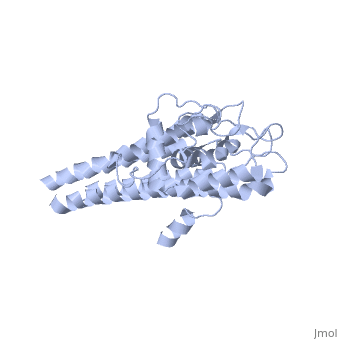VlsE of Borrelia
From Proteopedia
Lyme disease is a multistage, tick-borne infection that is prevalent in the United States, Europe, and Asia. The contributing bacterium that is related to this disease is the spirochete, Borrelia burgdorferi. VlsE is the lipoprotein of the Borrelia burgdorferi bacteria, which undergoes antigenic variation and plays a major role in the immune response to Lyme disease. A lipoprotein is a structure that contains both proteins and lipids, which allows the protein to integrate with the plasma membrane as a surface protein. It has an effective strategy developed by pathogenic microorganisms to evade the host immune system. The immune system normally reacts to antigens by producing particular antibodies to target that specific antigen. Memory B-cells will retain the proper antigenic counter for the foreign body. However, a variable antigen will frequently change the binding site, so the body will have to constantly look for a new antibody to target. Lyme disease can cause chronic neurologic, cardiovascular, and arthralgic manifestations lasting from months to years. Its persistence is due to the variable properties of the antigen, therefore it is important to understand the structure of vlsE to better counter this disease.
Structure of VlsEexists as a molecule in its natural form, comprised of two identical molecules bonded together through weak ionic interactions. The surface area interactions caused by dimerization, along with the variable and invariable , are central to understanding vlsE. VlsE contains N and C terminus, which correspond to the start of the amino acid sequence to the end, respectively. Unlike other proteins, the N and C terminus regions are neighbored and very flexible. Due to the fact that these regions do not change sequence, they are heavily used for diagnostic tests and vaccination experiments. There is little information on the antigenicity of the N-terminal, however, the C-terminal region is found to be highly immunogenic. Experiments involving treatment with antisera have shown the alpha structure of the C-terminal region associated with the immunogenicity to vary among Lyme disease Borrelia [1]. The peptide associated with this immunogenicity is membrane proximal and surface exposed, although crowding of vlsE proteins or bonding to other proteins may block exposure.[2] Burgdorferi uses antigenic variation to evade the host immune system. It uses genetic recombination as its antigenic variation strategy. The genes coding for vlsE’s variable regions are replaced by replicated vls silent cassette sequences on the B-31 locus, just upstream form the vlsE expression site, that are up to 92% similar to the corresponding vlsE sequences. This gene recombination results in many slightly varied versions of the vlsE antigen. Variable Domainconsists of one central which is comprised of six invariable regions (IR1 to IR6), and six variable regions (VR1 to VR6). These variable regions are highly immunogenic; they stimulate an immune response in the body and they serves as a major target of the host immune response. Most of the membrane-distal surface, which covers the α-helix, is made up of coiled forms of the VRs. The placement of these segments on the surface protects the hidden regions from coming into contact with antibodies and therefore serves as the immune evasion from antibody binding. The structure of vlsE indicates that the surface of the protein consists mainly of the variable regions, which go through rapid sequence changes at a high rate during the early stages of an infection. The variable regions on the surface cover the invariable regions of the protein. The exposed variable regions attract the antibodies and turn the immune system away from the invariable regions, leading to an evasion of the immune system. The invariable regions (IR) are important in maintaining the structure of the molecule, although some of the invariable regions also trigger . In humans, only IR6 does so, whereas in mice there is an immune response to IR6, IR2 and sometimes IR4.[2] These responses only apply to vlsE that is non-dimerized and detached from the membrane. However, when the antigenicity of IRs was tested on the vlsE of an intact B. burgdorferi, no detectable binding was found. When entering the amino acid sequence into an algorithm that calculates antigenicity, it is found that IR6 has a very high antigenic index.[3] This helps to explain why it elicites antibody response across all three species. IR2 and IR4 also have relatively high antigenic index as well, though not as high as IR6. The reason for the limited antigenic properties of these IRs in the natural form is because the dimer interactions between two molecules of vlsE greatly reduce the surface area to residue ratio, especially for IR4. Hindrance from other surface membranes may also affect the antigenicity. Relation to Lyme DiseaseThe more serious prolonged symptoms of Lyme Disease, known as post-Lyme disease syndrome, are attributed to the highly variable antigenic properties of vlsE. These symptoms include pain, fatigue and neurocognitive impairment and may occur in patients despite antibiotic treatment. (Chandra et. al). In addition to its successful antigenic variation strategy, these prolonged side effects may be due to targeted epitopes that have not yet been found. Recent studies using epitope mapping have shown sequences for targeted epitopes on the N and C terminus regions of the invariable domains in addition to the IR6 region. VlsE may contain many more epitope sequences than was previously thought. Future DirectionsFurther research must be done to determine why some immunodominant regions are not accessible to the antibody on the surface of spirochetes. For instance, IR6 is highly antigenic, but only accessible in the non-dimerized form (Liang & Philipp, 1999). Understanding this will allow us to find possible ways to vaccinate against Borrelia, and would be another step in finding a cure to Lyme disease. References
| ||||||||||||
Proteopedia Page Contributors and Editors (what is this?)
William Ji, Priya Madan, Maayan Vizana, Garshaw Amidi-Abraham, Alexander Berchansky, Michal Harel

